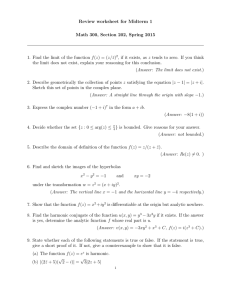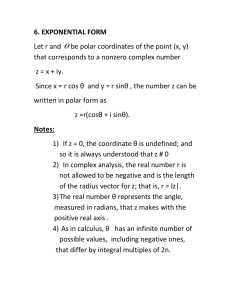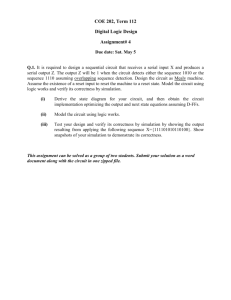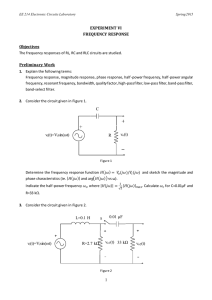handout with some details and an example
advertisement
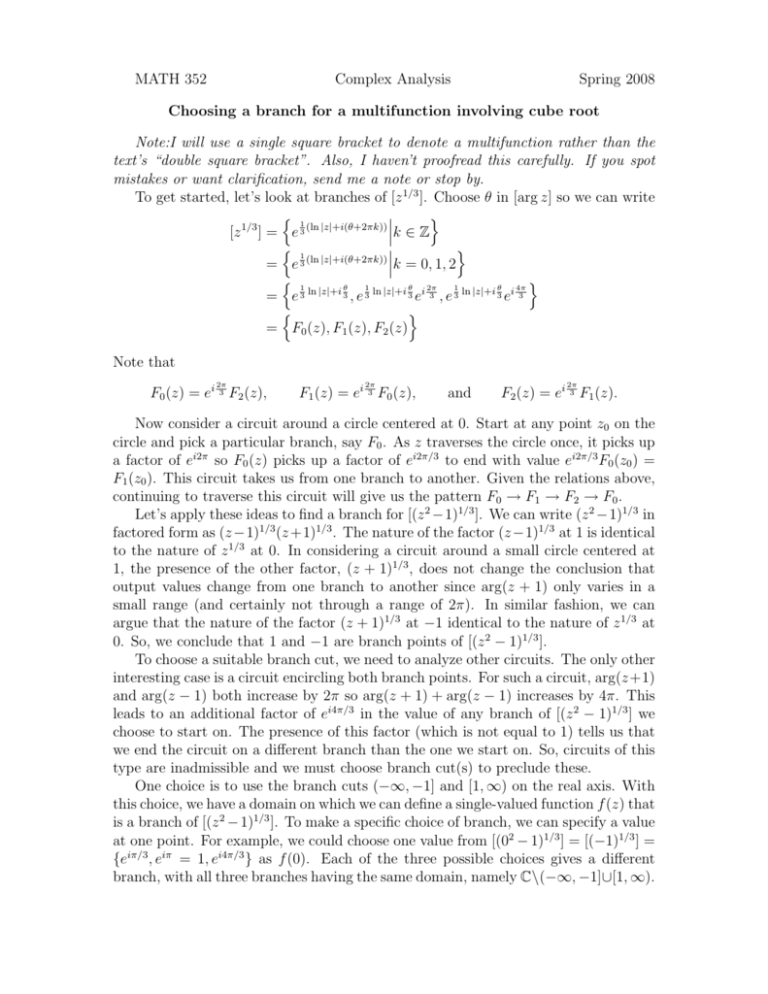
MATH 352
Complex Analysis
Spring 2008
Choosing a branch for a multifunction involving cube root
Note:I will use a single square bracket to denote a multifunction rather than the
text’s “double square bracket”. Also, I haven’t proofread this carefully. If you spot
mistakes or want clarification, send me a note or stop by.
To get started, let’s look at branches of [z 1/3 ]. Choose θ in [arg z] so we can write
¯
n 1
o
(ln |z|+i(θ+2πk)) ¯
1/3
3
[z ] = e
¯k ∈ Z
¯
o
n 1
¯
= e 3 (ln |z|+i(θ+2πk)) ¯k = 0, 1, 2
n 1
o
θ
1
θ
2π
1
θ
4π
= e 3 ln |z|+i 3 , e 3 ln |z|+i 3 ei 3 , e 3 ln |z|+i 3 ei 3
n
o
= F0 (z), F1 (z), F2 (z)
Note that
2π
F0 (z) = ei 3 F2 (z),
2π
F1 (z) = ei 3 F0 (z),
and
2π
F2 (z) = ei 3 F1 (z).
Now consider a circuit around a circle centered at 0. Start at any point z0 on the
circle and pick a particular branch, say F0 . As z traverses the circle once, it picks up
a factor of ei2π so F0 (z) picks up a factor of ei2π/3 to end with value ei2π/3 F0 (z0 ) =
F1 (z0 ). This circuit takes us from one branch to another. Given the relations above,
continuing to traverse this circuit will give us the pattern F0 → F1 → F2 → F0 .
Let’s apply these ideas to find a branch for [(z 2 −1)1/3 ]. We can write (z 2 −1)1/3 in
factored form as (z −1)1/3 (z +1)1/3 . The nature of the factor (z −1)1/3 at 1 is identical
to the nature of z 1/3 at 0. In considering a circuit around a small circle centered at
1, the presence of the other factor, (z + 1)1/3 , does not change the conclusion that
output values change from one branch to another since arg(z + 1) only varies in a
small range (and certainly not through a range of 2π). In similar fashion, we can
argue that the nature of the factor (z + 1)1/3 at −1 identical to the nature of z 1/3 at
0. So, we conclude that 1 and −1 are branch points of [(z 2 − 1)1/3 ].
To choose a suitable branch cut, we need to analyze other circuits. The only other
interesting case is a circuit encircling both branch points. For such a circuit, arg(z +1)
and arg(z − 1) both increase by 2π so arg(z + 1) + arg(z − 1) increases by 4π. This
leads to an additional factor of ei4π/3 in the value of any branch of [(z 2 − 1)1/3 ] we
choose to start on. The presence of this factor (which is not equal to 1) tells us that
we end the circuit on a different branch than the one we start on. So, circuits of this
type are inadmissible and we must choose branch cut(s) to preclude these.
One choice is to use the branch cuts (−∞, −1] and [1, ∞) on the real axis. With
this choice, we have a domain on which we can define a single-valued function f (z) that
is a branch of [(z 2 − 1)1/3 ]. To make a specific choice of branch, we can specify a value
at one point. For example, we could choose one value from [(02 − 1)1/3 ] = [(−1)1/3 ] =
{eiπ/3 , eiπ = 1, ei4π/3 } as f (0). Each of the three possible choices gives a different
branch, with all three branches having the same domain, namely C\(−∞, −1]∪[1, ∞).
For completeness, let’s check if [w(z)] = [(z 2 − 1)1/3 ] has a branch point at infinity.
To do this, we check if [w(1/z)] has a branch point at 0. So, compute
w
´1/3 ³ 1 − z 2 ´1/3 (1 − z 2 )1/3
¡1¢ ³ 1
= 2 −1
=
.
=
z
z
z2
z 2/3
Because of the factor z 2/3 in the denominator, this does have a branch point at 0.
(Note that this also has branch points at −1 and 1 but these are not relevant here.)
The presence of a branch point at infinity for [(z 2 − 1)1/3 ] tells us that we must have
at least one branch cut that extends to ∞.
You should do the calculation to confirm that [(z 2 − 1)1/2 ] does not have a branch
point at infinity. For this multifunction, it is not necessary to use a branch cut that
extends to ∞ (although it is allowed to use one).

